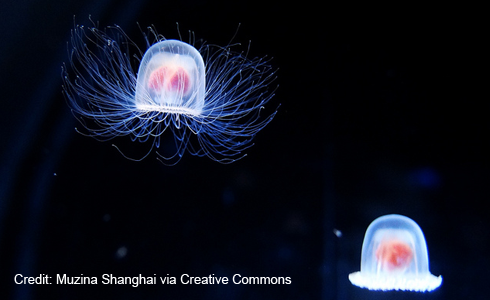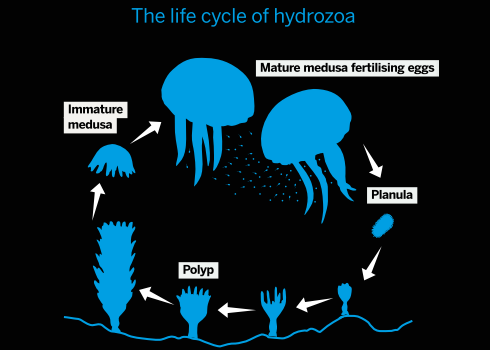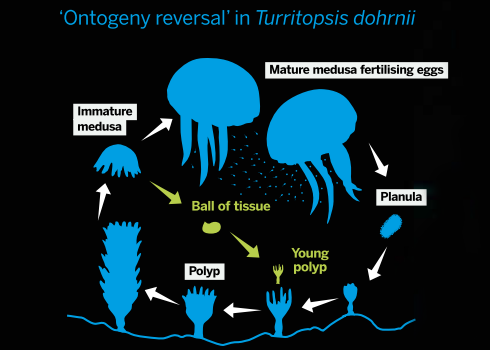Everlasting life: the ‘immortal’ jellyfish

The supposedly 'immortal' jellyfish Turritopsis dohrnii has captivated scientists since it was discovered decades ago. One of the first researchers to study it, Ferdinando Boero, looks at whether this amazing organism really can live forever
The Biologist 63(3) p16-19
As with so many findings, the so-called 'immortal jellyfish' was discovered by accident. During a visit to my laboratory in the 1980s, a German student, Christian Sommer, and my very first student, Giorgio Bavestrello, collected a hydrozoan thought to be Turritopsis nutricula. This small, predatory marine invertebrate has two stages in its life cycle: a polyp-forming colony called a hydroid and the more mobile, recognisably jellyfish-like form called medusae. After being collected and reared in our lab, our Turritopsis hydroid released medusae. Then Sommer forgot about them.
Normally, in the hydrozoan life cycle, medusae mature and then spawn sperm and eggs. Any fertilised eggs become small larvae called planula. When these planula settle somewhere, a new hydroid colony grows once again, and eventually polyps in the colony release more medusae (below).
The regeneration game

Mere mortals
Medusae mature and spawn sperm and eggs. Fertilised eggs become small larvae called planula, which settle and produce a new hydroid colony.

Let's go round again
Turritopsis dohrnii has been seen to age in reverse, skipping several life cycle stages and reverting to an earlier stage of development, at which point it begins its life cycle again.
The medusae of the species we believed we had are not released with mature gonads. Normally they have to go off and grow, and become sexually mature, before spawning and eventually producing new planulas. Again, the planulas settle and produce new polyp colonies and, meanwhile, the medusae die.
When Sommer next checked the rearing jar, there were lots of newly settled polyps on its bottom. Puzzled by this, Sommer and Bavestrello continued their observations. They found that the new medusae, if stressed, fell on the bottom of the jar and transformed straight into polyps, skipping the fertilisation and larval stages (see above). This was even stranger – like a butterfly transforming back into a caterpillar.
The observation was so revolutionary that it was presented at the second workshop of the Hydrozoan Society[1]. It was so revolutionary in fact that one of the attendees, the late Volker Schmid, expressed serious doubts about the report. He said it was impossible.
Schmid had worked extensively on cell biology related to the life cycle of Podococoryna (another hydrozoan) and said that the cells of the medusa buds, while still forming from the polyp, could occasionally revert back to polyp cells. However, he thought once the medusa differentiation was complete, the reversal was impossible.
The workshop took place in a marine laboratory and we had access to the field, so I went diving and found some colonies of Turritopsis with medusae. I brought them to Volker and we obtained the newly liberated medusae. And then, under the eyes of Volker, the mildly stressed medusae (a little pinch with a tweezer is enough) transformed into polyps. They first became a ball of tissue and fell on the bottom of the jar. Then the ball of tissue produced a hydrorhiza (the basal stolon of a new hydroid) and, from it, a new polyp came out. Volker was amazed.
He had described transdifferentiation in certain hydrozoan cells before[2], but this was simply too much. Transdifferentiation is the dedifferentiation of a differentiated cell into some sort of stem cell, and then differentiation of that into another cell type. In this case, however, apparently all the cell types of the medusa dedifferentiated and then redifferentiated into the cell types of the polyp, producing an entirely new body plan (that of the polyp) from a previous one (that of the medusa, which, indeed, was not 'previous' but 'subsequent' to the polyp stage).
Fact file
Where do 'immortal' jellyfish live?
Turritopsis prefer warmer waters, although they have been spotted in colder areas as well. They originate in the Caribbean Sea (nutricula) and the Mediterranean (dohrnii).
What do the jellyfish feed on?
Their diet consists of plankton, fish eggs and small molluscs.
How big are they?
They are tiny, at a maximum of 4.5mm tall and wide. Younger jellyfish have only eight tentacles and are 1mm tall, while adults can have up to 90 tentacles.
What are the implications for humans?
Transdifferentiation could help scientists find new ways to repair or regenerate damaged tissue.
Another ex-student of mine, Stefano Piraino, was at that workshop. Bavestrello and Sommer did not proceed with the study, but Piraino jumped in, starting a collaboration with Volker. We planned experiments aimed at following the transdifferentiation at a cellular level, and another account on the phenomenon came out[3].
We were very excited by the development of our friends' initial discovery, with such an amazing case of apparent 'ontogeny reversal' via transdifferentiation. We sent it to Nature, as nothing like that had ever been reported before, with detailed cellular studies. But Nature rejected it, advising us to send it to a marine biology journal.
When the paper was published, I prepared a press release for my university to publicise what we had found: the cells of the medusa transdifferentiating into polyp cells, leading to ontogeny reversal. Federico Di Trocchio, a professor at the University of Lecce, who took care of the press room at the time, did not like the technical jargon I had used – and rightly so. He used a word that we would never have used: immortality.
That triggered the saga of the 'immortal jellyfish'. The press went crazy about it, and we were inundated with interview requests, first from Italy and then from all over the world. The frenzy for the immortal jellyfish is not yet over, after 20 years, and the phenomenon has been cited in everything from TV series such as The Big Bang Theory to the McGraw-Hill Yearbook of Science and Technology[4].
Japanese scientist Shin Kubota, who had worked at Lecce several times, found Turritopsis in Japan and started to rear them in his laboratory, keeping them in an almost eternal loop of back and forth transdifferentiations[5]. Further studies have shown that ontogeny reversal is also possible in other cnidarian species[6].
To summarise – Sommer and Bavestrello detected the phenomenon, Piraino and Schmid disentangled it at cellular level, and Kubota showed that the reversal can be repeated several times. But the mystery of the immortal jellyfish is not solved yet.
Every cell contains all the information necessary to build a new whole organism, but only part of this information is actually used once a cell becomes differentiated. What is the molecular mechanism that allows a resetting of the developmental information across all cells, leading to ontogeny reversal? The genome of Turritopsis dohrnii is being investigated and decoding it will be the first step towards the search for an 'immortality switch'.
No wonder the media is still excited about this possibility.
There is a little inconvenience, though. It is not easy to obtain mass cultures of Turritopsis, and all work has to rely on material collected in the field. Laboratory animals have a common feature: they are easy to rear, and most research is focused on just a few species that, indeed, are exceptional in this respect.
The lesson of Turritopsis is profound: if we explore biodiversity, we will find exceptional organisms that do exceptional things. Focusing on the few species that can be reared easily in the laboratory is a myopic attitude that prevents us from finding other marvels.
References
1) Bavestrello, G. et al. Bi-directional conversion in Turritopsis nutricula (Hydrozoa). Aspects of Hydrozoan Biology, Scientia Marina. 56(2–3), 137–140 (1992).
2) Schmid, V. et al. Transdifferentiation and regeneration in vitro. Developmental Biology 92(2), 476–488 (1982).
3) Piraino, S. et al. Reversing the life cycle: medusae transforming into polyps and cell transdifferentiation in Turritopsis nutricula (Cnidaria, Hydrozoa). Biol. Bull. 190(3), 302–312 (1996).
4) Boero, F. et al. Ontogeny. AccessScience. (McGraw-Hill Education, 2014).
5) Kubota, S. Turritopsis sp. (Hydrozoa, Anthomedusae) rejuvenated four times. Bulletin of the Biogeographical Society of Japan 64, 97–99 (2009).
6) Piraino, S. et al. Reverse development in Cnidaria. Canadian Journal of Zoology 82(11), 1748–1754 (2004).
Ferdinando Boero is a professor of zoology at the Department of Biological and Environmental Sciences and Technologies at the Università del Salento in Lecce, Italy.


